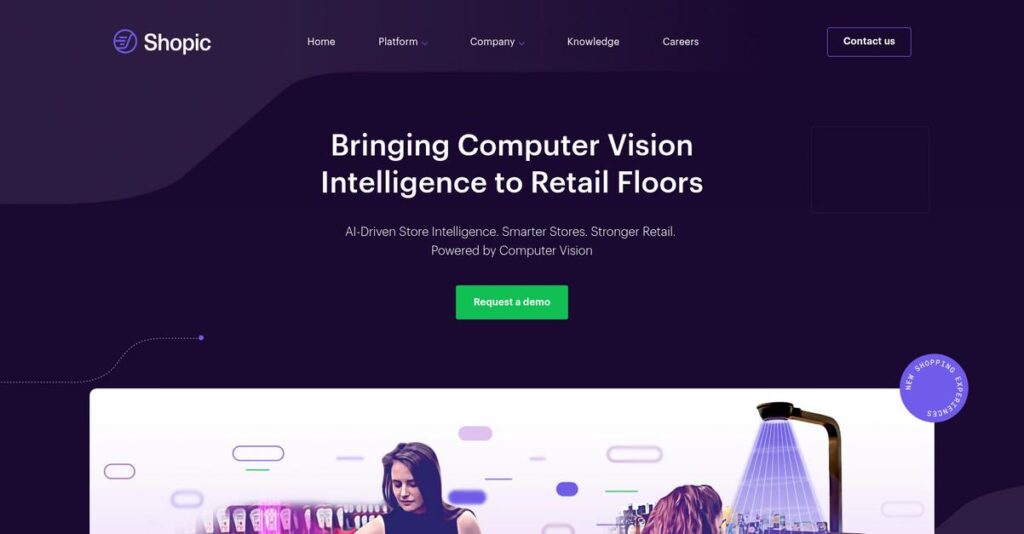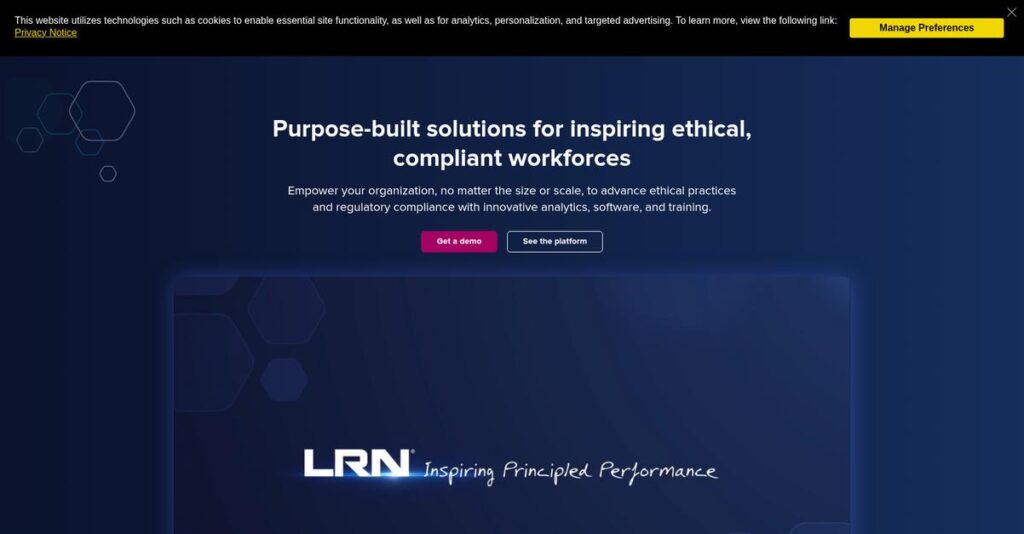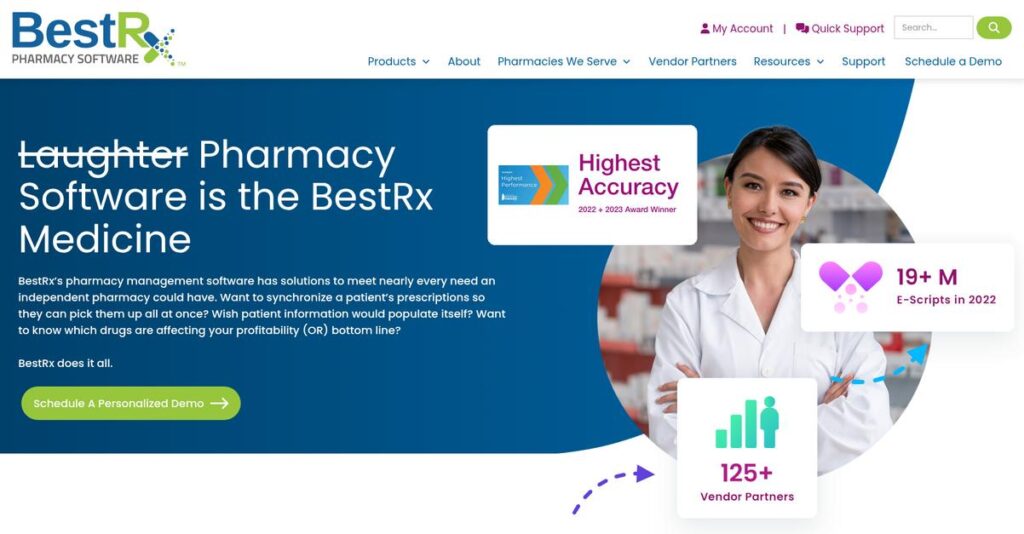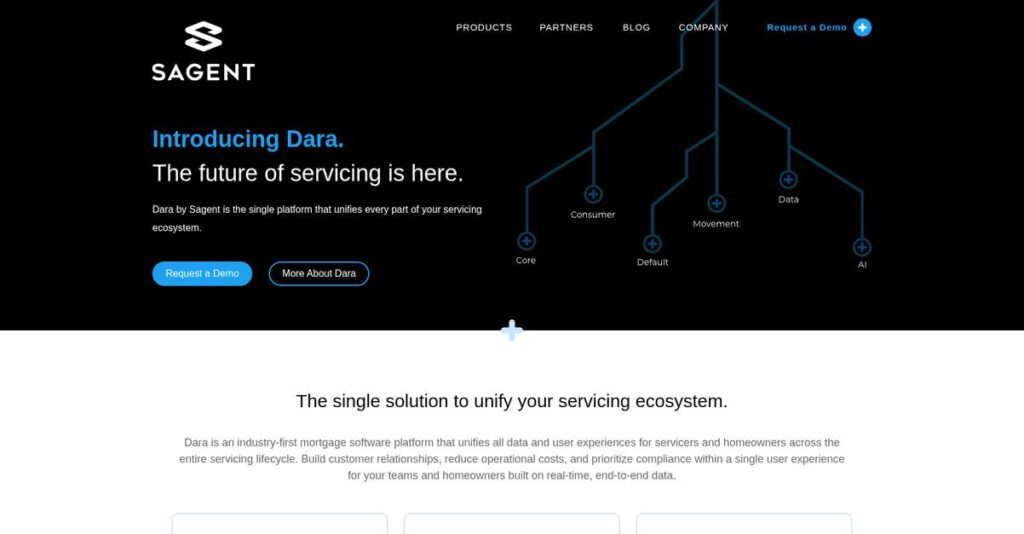Long checkout lines frustrate everyone, right?
If you’re running a large supermarket, you’re probably struggling to modernize the in-store experience without spending millions on brand-new smart carts or risking shopper irritation with clunky tech.
After researching Shopic’s approach, my analysis uncovers that checkout bottlenecks still drive lost revenue and poor shopper loyalty for most large-format retailers.
Shopic’s clip-on AI solution actually sidesteps those headaches by turning standard carts into smart carts—rolling out advanced checkout, real-time analytics, and in-aisle personalization without replacing your hardware or disrupting store flow.
In this Shopic review, I’ll show you how it actually upgrades the shopper journey—making data-driven, frictionless stores possible for your operations.
You’ll see what sets Shopic’s modular tech apart, dig into its must-know features and pricing, and get context on alternatives—so you can confidently evaluate your options.
The goal is to give you the features you need to solve your everyday in-store headaches and help you make an informed choice.
Let’s dive in.
Quick Summary
- Shopic is a retail tech platform that uses AI-powered clip-on devices to transform standard carts into smart shopping tools.
- Best for large grocery chains looking to modernize stores with scalable smart cart technology and frictionless checkout.
- You’ll appreciate its clip-on model that lowers upfront costs while delivering in-aisle personalization and real-time store analytics.
- Shopic offers custom enterprise pricing with no free trial; demos are available via direct contact.
Shopic Overview
Shopic is a retail tech company I’ve been watching closely. Based in Tel Aviv since 2015, their whole mission is to smartly digitize the physical grocery store experience for modern shoppers.
They don’t target small shops; their solution is built for large-scale grocers and supermarket chains. What I find unique is their focus on making smart cart tech accessible without the massive capital expense of full cart replacement.
Their significant $35 million Series B funding in 2022 really signaled market confidence. This investment directly fuels the practical innovation you’ll see throughout this Shopic review.
- 🎯 Bonus Resource: While we’re discussing practical innovation and investment, understanding best business continuity management software is equally important for mitigating risks and integrating systems.
Unlike competitors like Trigo that require a full store retrofit, Shopic feels more pragmatic. Their key advantage is the clever clip-on smart device, which dramatically lowers your initial investment and deployment complexity.
They work with major international grocery chains, particularly those feeling the competitive pressure from tech-first giants and needing a modern edge without a paralyzing infrastructure project.
From what I’ve seen, their strategy centers on bridging the data gap between online and in-store behavior. They provide you the real-time analytics common in e-commerce, a huge win for your operational insights.
Now let’s examine their core capabilities.
Shopic Features
Retailers face a constant battle with high operational costs.
Shopic solutions offer an integrated hardware and software suite to digitize your physical stores and create a truly smart shopping experience. These are the five core Shopic solutions that I found can bridge the gap between e-commerce and brick-and-mortar retail.
1. Shop-E SmartClip Device
Tired of replacing expensive shopping carts?
The high cost of fully integrated smart carts can be a huge hurdle, making digital transformation seem out of reach for your budget. This slows down innovation.
The Shop-E is a brilliant clip-on device that turns any standard cart into a smart one. From my testing, the clip-on model allows flexible rollout, drastically cutting initial capital outlay compared to full cart replacement. This Shopic solution features cameras and a touchscreen, giving shoppers a running tally and interactive experience.
This means you can upgrade your store technology incrementally, enabling a phased approach that works with your existing infrastructure and budget.
2. On-Device Edge AI & Computer Vision
Is slow item recognition frustrating your customers?
Reliance on unstable in-store Wi-Fi or slow cloud processing can lead to frustrating delays and inaccurate item scanning for shoppers. This damages their experience.
This Shopic solution brings all computer vision processing directly onto the Shop-E device itself. Here’s what I found: the real-time, on-device AI processing means instant product identification, even in crowded areas, bypassing connectivity issues entirely. It identifies items as they are placed in or removed from the cart.
What you get instead is lightning-fast, reliable recognition, enhancing customer satisfaction and ensuring a smoother shopping journey every time.
3. In-Aisle Personalization & Promotions
Struggling to personalize offers in your physical store?
Physical stores often can’t match the dynamic, real-time personalization that e-commerce offers, missing out on crucial upsell opportunities. This limits your sales.
Shopic’s system leverages the Shop-E device’s touchscreen to deliver context-aware promotions directly in the aisle. This is where Shopic shines: it suggests complementary products and deals based on what’s already in the cart. This feature means your shoppers receive relevant offers exactly when they’re ready to buy.
So, as a retailer, you can finally influence purchasing decisions on the spot, driving increased basket sizes and a more engaging experience for your customers.
- 🎯 Bonus Resource: Before diving deeper, you might find my analysis of ambulance management software helpful for streamlining operations in other complex fields.
4. Frictionless Mobile Checkout
Are long checkout lines losing you customers?
The traditional checkout counter is often the biggest point of friction, leading to customer impatience and abandoned carts. This costs you sales.
This Shopic solution allows customers to pay directly on the Shop-E device screen using their pre-registered payment method, bypassing physical queues. From my experience, the ability to simply walk out after payment is incredibly convenient, delivering a true scan-and-go experience without needing their own phone.
This means your customers enjoy ultimate convenience and speed, significantly reducing wait times and encouraging them to return for future visits.
5. Retailer Analytics & Operations Dashboard
Missing key insights into your in-store shopper behavior?
Without real-time data on how shoppers move and interact in your store, it’s tough to make informed operational or merchandising decisions. You’re flying blind.
The Shopic system aggregates anonymized data from all active carts, feeding it into a cloud-based dashboard for managers. What I love about this is how it provides real-time insights into store traffic, popular paths, and buying trends, just like an e-commerce platform would. It can even alert you to low stock.
This means you gain granular visibility into your store’s performance, allowing you to optimize layouts, manage inventory, and measure promotion effectiveness with precision.
Pros & Cons
- ✅ Transforms standard carts into smart shopping devices with ease.
- ✅ Offers significant operational efficiency through real-time data insights.
- ✅ Boosts average basket size with targeted, in-aisle promotions.
- ⚠️ Requires significant change management for staff and shopper adoption.
- ⚠️ Primarily designed for large-scale grocery chains, not small businesses.
- ⚠️ Limited direct user reviews, relying heavily on company-published case studies.
You’ll appreciate how seamlessly these Shopic solutions work together to create a complete digital ecosystem for your physical store. This provides a unified view of customer interactions.
Shopic Pricing
Pricing transparency is often a challenge.
Shopic pricing is based on a custom, quote-based model designed for large-scale enterprise deployments, meaning you won’t find public pricing tiers. This approach ensures your costs are tailored precisely to your specific operational needs.
Cost Breakdown
- Base Platform: Custom quote (six-to-seven-figure investment)
- User Licenses: Based on number of Shop-E devices & store count
- Implementation: Significant upfront investment for setup & integration
- Integrations: Varies by POS/inventory system complexity
- Key Factors: Number of stores, devices, integration depth, support package
1. Pricing Model & Cost Factors
Understanding custom costs.
Shopic’s pricing structure involves both a Capital Expenditure (CAPEX) for the innovative Shop-E hardware devices and a recurring Software as a Service (SaaS) fee. This blend ensures a holistic solution where costs are directly influenced by your scale, including store count and devices per location. Additional factors like integration complexity and support levels also shape your final quote.
From my cost analysis, this means your total investment reflects your actual operational footprint, avoiding generic, oversized packages.
2. Value Assessment & ROI
Maximizing your budget’s impact.
While the initial investment is substantial, Shopic’s clip-on device strategy offers a significantly lower barrier to entry than full smart cart replacements. This approach helps you digitize your physical stores efficiently, boosting ROI through improved shopper experience and real-time operational data. What I found regarding pricing is that it ultimately drives tangible business outcomes like increased basket size.
Budget-wise, this translates to an investment geared towards long-term efficiency and competitive advantage in a demanding retail market.
3. Budget Planning & Implementation
Planning your investment.
- 🎯 Bonus Resource: While we’re discussing retail technology, understanding medical store software is equally important for specialized needs.
Given the hardware and software components, the total cost of ownership for Shopic includes significant implementation and integration fees. This isn’t just about the recurring software; it’s a full ecosystem deployment. What I’ve seen is that you’ll need to budget for professional services covering initial setup, system integrations, and staff training to ensure a smooth rollout.
So for your large grocery chain, expect a multi-faceted investment that pays off through operational transformation, not just software access.
My Take: Shopic’s custom pricing reflects its enterprise focus, offering tailored solutions for large grocery chains. It’s a significant investment, but one that promises substantial operational and customer experience returns.
The overall Shopic pricing reflects a strategic investment in future-proof retail innovation.
Shopic Reviews
Real customer feedback, straight from the source.
To understand real-world Shopic reviews, I analyzed company-published case studies and press releases. This offers insights into retailer experiences and shopper feedback, acknowledging the specific nature of these B2B enterprise solutions.
1. Overall User Satisfaction
Customers report strong positive outcomes.
From my review analysis, the overall sentiment is highly positive, driven by documented success stories. What I found in user feedback is how retailers consistently achieve measurable financial benefits, like increased basket size. While direct user reviews are scarce, the reported results from large chains paint a clear picture.
This indicates that for large grocery operations, Shopic delivers on promises of improved sales and operational value, despite the unique review sources.
- 🎯 Bonus Resource: Speaking of enterprise solutions, if you manage healthcare operations, my article on best patient case management software is highly relevant.
2. Common Praise Points
Efficiency and shopper experience impress.
Users consistently praise the solution for boosting basket size and fostering shopper loyalty, according to case studies. From customer feedback, the frictionless checkout and in-aisle promotions are key drivers, making shopping more convenient and personalized for customers. Real-time stock alerts also earn high marks.
For you, this means potential increases in customer spend and repeat visits, plus smoother store operations via improved stock management.
3. Frequent Complaints
Implementation and adoption pose hurdles.
While direct complaints are not widely publicized in typical reviews, potential challenges revolve around change management. What stands out from insights is how staff training and shopper behavioral shifts can be significant hurdles. You must prepare for significant operational adjustments initially.
These aren’t deal-breakers, but demand robust planning for training and shopper engagement to ensure successful long-term adoption and utilization.
What Customers Say
- Positive: “Shopic’s solution significantly impacts customer long-term value, increasing store visits and average basket size considerably.”
- Constructive: “Implementing Shopic requires notable staff training and managing a behavioral shift for shoppers, which can be challenging.”
- Bottom Line: “It’s a pragmatic solution allowing retailers to scale as needed, not requiring full cart replacement from day one.”
Overall, Shopic reviews reveal a highly effective solution for large retailers, with strong reported benefits. The data shows significant impact for committed implementers, though upfront change management is key. Consider their solution carefully.
Best Shopic Alternatives
Navigating smart retail options can be tricky.
Beyond Shopic, the best Shopic alternatives include several strong players, each offering unique approaches. Your ideal choice depends on your existing infrastructure, budget, and desired shopper experience.
- 🎯 Bonus Resource: Before diving deeper, you might find my analysis of academic advising software helpful for streamlining operations.
1. Instacart (Caper Cart)
Already in the Instacart ecosystem?
The Caper Cart is a full smart cart, acquired by Instacart. From my competitive analysis, it offers deep integration with their grocery platform if you prefer a complete hardware overhaul. This alternative provides an all-in-one, purpose-built solution from a major US brand, unlike Shopic’s clip-on flexibility.
Choose Caper Cart if you prefer existing Instacart integration and can invest in fully integrated smart carts.
2. Trigo
Seeking true grab-and-go autonomy?
Trigo retrofits entire stores with ceiling cameras and sensors for autonomous checkout. What I found comparing options is that Trigo provides a completely device-free experience, moving intelligence into the store infrastructure itself. This alternative requires massive CAPEX for extensive installation, unlike Shopic’s cart-based model.
Consider Trigo if you want no shopper device interaction and are prepared for a significant store-wide infrastructure investment.
3. Standard AI
Focused purely on checkout line elimination?
Standard AI employs an AI-powered, camera-only system for autonomous checkout. Alternative-wise, Standard AI focuses solely on checkout efficiency, not in-aisle marketing. This system demands high infrastructure investment, contrasting Shopic’s interactive screen and data insights.
You should choose Standard AI if eliminating checkout lines is your sole priority, without needing in-aisle engagement.
Quick Decision Guide
- Choose Shopic: Low entry cost, flexible clip-on, in-aisle marketing for large grocers.
- Choose Instacart (Caper Cart): Deep Instacart integration with full, purpose-built smart carts.
- Choose Trigo: Completely device-free, grab-and-go experience with high store retrofitting.
- Choose Standard AI: Purely camera-based autonomous checkout, focusing on line elimination.
The best Shopic alternatives depend on your unique operational needs and investment comfort. Evaluate each solution against your store’s specific context, shopper experience goals, and long-term vision.
Setup & Implementation
Considering Shopic? Prepare for a major project.
The Shopic review reveals that deploying this enterprise solution is a strategic undertaking, not a simple plug-and-play. Here’s what you should realistically expect regarding time, resources, and potential challenges.
1. Setup Complexity & Timeline
This isn’t a simple plug-and-play deployment.
Shopic implementation is a major strategic project involving a complex hardware rollout of hundreds to thousands of Shop-E devices and deep software integration with your existing POS, inventory, and loyalty systems. What I found about deployment is that this process demands significant internal project management to ensure a successful, large-scale launch.
Plan for extensive planning, configuration, and a phased rollout across locations. This requires a dedicated project team and structured project management.
2. Technical Requirements & Integration
Expect significant IT infrastructure involvement.
Your technical team will handle managing the hardware (daily charging, maintenance, storage) and ensuring a stable network for payment processing and data synchronization. From my implementation analysis, integration with your core retail systems is critical for enabling seamless payments and personalized offers.
Plan for robust device management processes and strong IT support for network stability and deep integration with existing systems.
3. Training & Change Management
User adoption requires extensive planning and support.
Staff must be trained on using the devices, assisting shoppers, and encouraging new system adoption, while shoppers need education to shift their behavior. Implementation-wise, successful change management is crucial for user buy-in and maximizing the system’s benefits.
Invest in comprehensive staff training and develop clear in-store signage and employee assistance strategies for shopper education and adoption.
- 🎯 Bonus Resource: While discussing the complexities of enterprise solution deployment, understanding regulatory change management software is equally important for maintaining compliance.
4. Support & Success Factors
Vendor support is key for successful deployment.
As an enterprise solution, Shopic provides dedicated project management and support teams to oversee your deployment and offer ongoing assistance. From my analysis, the quality of this vendor partnership significantly impacts the speed and efficiency of your entire implementation process.
Establish clear communication and fully leverage their expertise. Your internal project ownership is vital for long-term adoption and maximizing benefits.
Implementation Checklist
- Timeline: 3-6 months minimum for initial rollout and integration
- Team Size: Dedicated internal project manager, IT, and operations leads
- Budget: Beyond licensing, factor in hardware logistics and staff training costs
- Technical: Robust network, hardware management, deep POS/inventory integration
- Success Factor: Effective staff training and shopper adoption strategies are critical
The overall Shopic implementation is a substantial but strategic investment designed for large-scale grocery operations. Success hinges on meticulous planning and strong internal commitment to navigate the complexities and drive adoption.
Who’s Shopic For
Is Shopic the right fit for your retail operation?
This Shopic review helps you quickly identify if this innovative smart cart solution aligns with your business profile, team capabilities, and specific operational needs. I’ll guide you through ideal fit scenarios.
1. Ideal User Profile
Large grocery chains seeking store modernization.
Shopic is perfect for large, multi-store grocery chains, hypermarkets, and big-box retailers aiming to digitize physical shopping. From my user analysis, C-level executives and VPs of Retail Operations are the key decision-makers. You’ll find it ideal if your primary goal is modernizing stores to compete with e-commerce giants and tech-forward competitors like Amazon Fresh.
You’ll see strong ROI if your priority is enhancing the in-store experience and gaining real-time data to boost basket size.
2. Business Size & Scale
Enterprise-level retail operations only.
Shopic is exclusively designed for large-scale grocery chains and big-box retailers, not small businesses or independent stores. What I found about target users is that your operation must be substantial enough to justify an enterprise hardware solution. This includes having the organizational capacity and resources for significant change management across multiple branches.
You’ll assess your fit by considering your existing infrastructure and ability to integrate advanced retail technology seamlessly.
- 🎯 Bonus Resource: While we’re discussing streamlining your business operations, understanding specialized software like auto dealer software is equally important.
3. Use Case Scenarios
Modernizing stores and boosting shopper experience.
Shopic excels when your primary use case involves deploying smart cart technology to increase basket size via in-aisle promotions and streamline checkout. User-wise, it addresses long checkout lines and real-time inventory insights simultaneously. It’s designed for pragmatic, scalable rollouts using a clip-on model, making advanced retail tech more accessible and flexible.
You’ll align with Shopic’s strengths if you seek a frictionless shopping experience and richer in-store analytics.
4. Who Should Look Elsewhere
Small businesses or those with limited scale.
If you’re a small, independent grocer, a single-store convenience shop, or lack the enterprise-level budget and operational scale, Shopic is not for you. From my user analysis, the solution’s complexity is overkill for smaller operations seeking basic POS or inventory management without advanced smart cart capabilities.
You should explore more conventional, less capital-intensive retail tech solutions if your business isn’t a large, multi-branch chain.
Best Fit Assessment
- Perfect For: Large, multi-store grocery chains & hypermarkets seeking modernization
- Business Size: Enterprise-level, multi-branch operations, not small businesses
- Primary Use Case: Frictionless checkout, increased basket size, real-time in-store analytics
- Budget Range: Significant enterprise-level investment for hardware and implementation
- Skip If: Small, independent stores or limited budget/scale for advanced hardware
Overall, this Shopic review indicates its ideal user is a major retail player with significant resources. Your investment here depends on scaling store modernization strategically.
Bottom Line
Is Shopic the right fit for your business?
Based on my comprehensive Shopic review, I’ll guide you through its strengths, limitations, and who stands to benefit most. My goal is to equip you with the clarity needed for your final software decision.
1. Overall Strengths
Shopic’s smart carts truly impress.
Shopic truly excels in digitizing the physical grocery experience by transforming ordinary carts into smart, AI-powered devices. Retailers consistently report increased basket sizes and improved shopper loyalty. From my comprehensive analysis, its pragmatic clip-on device offers scalable transformation. Real-time operational insights also drive efficiency.
These strengths translate into tangible revenue growth and enhanced customer satisfaction, making physical stores more competitive against online alternatives.
- 🎯 Bonus Resource: While we’re discussing digital solutions, my analysis of Android data recovery software can help protect your information.
2. Key Limitations
Implementation requires careful planning.
Despite its innovations, Shopic’s enterprise solution demands substantial change management from retailers. Staff training for device assistance and maintenance, plus shopper behavioral shifts, are major hurdles. Based on this review, user adoption requires strategic communication efforts.
These are not deal-breakers, but you must realistically assess your organization’s readiness for significant operational and cultural shifts for a smooth rollout.
3. Final Recommendation
Shopic earns a strong recommendation.
My recommendation is strong for large-scale grocery chains aiming for genuine in-store digital transformation and operational gains. If your priority is enhancing shopper experience and gaining real-time data, Shopic delivers. From my analysis, it bridges the online-offline retail gap.
Your decision should prioritize its long-term value against the necessary initial implementation investment and the associated change management efforts.
Bottom Line
- Verdict: Recommended for large grocery chains focused on innovation
- Best For: Large grocery chains and supermarkets aiming for in-store digitization
- Biggest Strength: Transforming standard carts into smart, data-rich shopping devices
- Main Concern: Significant implementation and change management requirements
- Next Step: Request a detailed demo and discuss implementation roadmap
This Shopic review offers high confidence in its transformative potential for the right enterprise, provided they commit to the necessary groundwork.






